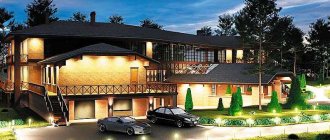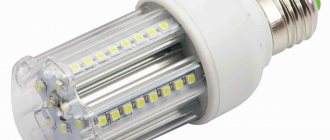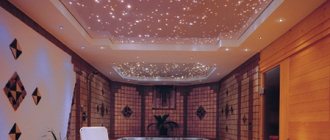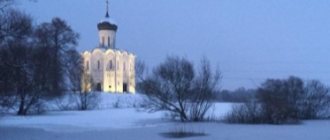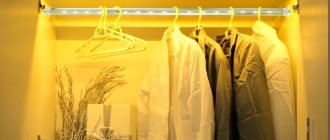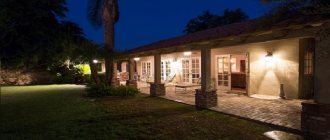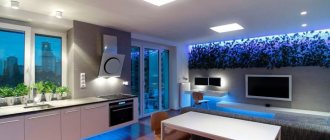The lighting design of the facade at night decorates the building, giving it a cozy and hospitable appearance. The article describes the principles of creation and functions of lighting the facades of private houses. You will learn the stages involved in developing an architectural lighting plan and what lighting equipment is used. The article will introduce you to the types of backlighting: flood, local and hidden, with their features and methods of implementation.
You can't help but admire it Source rupurt.com
About the functions of backlighting and the principles of its creation
Light design of facades is one of the ways of arranging the local area; owners of country houses are happy to use it as an additional element of the decor of their homes. Facade lighting can perform two functions:
- Aesthetic . Using techniques for illuminating the facade, you can highlight the architectural features of the house, give it a unique look, and make it stand out from the surrounding buildings.
- Practical . Facade lighting equipment illuminates not only the walls of the house. By decorating your home, you illuminate the surrounding area and ensure safe movement after sunset. For this purpose, individual elements are additionally illuminated - the porch or the entrance to the house.
To ensure that architectural lighting pleases the eye and does not cause trouble, it is arranged in compliance with the following principles:
- The system and its components must have the simplest and most reliable design possible . LED lamps have proven to be one of the easiest to use.
The charm of an illuminated facade Source netmostwebdesign.com
- The system must be economical in energy consumption.
- Facade lighting must be absolutely safe for residents of the house and their pets and comply with modern operational standards.
- It is desirable for the system to operate in automatic mode .
- The system must be maintainable .
Installation requirements
Properly performed installation work will help to avoid difficulties during further operation and maintenance of the facility. And errors in the installation of LED lamps, in turn, lead to premature failure of the equipment.
Features of the organization of illumination of building facades:
- Historical monuments and leisure centers are often decorated in a brighter, festive style. This way they attract more attention and fulfill the true intent of the designers.
- When designing lighting, it is important to consider what materials were used in construction and decoration: glass, metal, concrete or brick.
- As a rule, lamps are mounted in the upper part of the facade - for soft dispersion of light.
- When installing luminaires, it is necessary to ensure free access to wires and power supplies. During equipment maintenance and repair, this factor plays an important role.
When designing architectural lighting, various additional devices can be used. The use of specialized software, sensors and light control systems can reduce energy costs and increase the efficiency of lighting of buildings and structures.
From us you can order everything you need for high-quality architectural lighting of building facades - we work in Moscow, St. Petersburg, in all regions of Russia and in neighboring countries!
Methods of organization and types of lighting
Facade lighting can be organized in different ways. Architectural practice includes lighting not only the main, front side of the building, but also the side walls. Contrary to popular belief, creating lighting design does not require the use of complex technical techniques and high consumption of materials. At the same time, it is necessary to strive for a harmonious result - all light sources must fit into the overall concept of lighting the area. The most common ways to organize lighting include:
- Installation of lighting sources on the walls of the building.
- Installation of hidden lamps .
- Use of remote lighting fixtures .
- Combination of methods.
All these lighting sources have different purposes and characteristics, so when choosing certain lighting elements, it is worth considering their functionality. To illuminate the facade, three types of lighting are organized:
- Decorative . Its only purpose is to create a spectacular view that will be the envy of neighbors and friends. In this case, it is allowed to highlight both individual facade details (for example, illumination of the roof of a house), as well as nearby plants and decorative elements of the local area.
- Technical . Auxiliary, enabling comfortable and safe use of stairs, house paths, doors.
- Accompanying . A type of technical; organized with the help of lighting fixtures equipped with special sensors that react by turning on when a person approaches.
Decorative lighting design Source ukrasheniyedoma.com
Types of facade lighting of buildings
Contour architectural lighting of the house
LED strips or flexible neon are typical elements for creating contour architectural lighting for a building. With this method of lighting design, building elements are emphasized along the contours of windows, roofs, ceilings, columns or balconies, entrance steps, creating a unique and attractive appearance of the house and emphasizing all the advantages of its architecture, but it must be taken into account that not all architectural solutions are suitable for contour lighting. Often contour lighting is used to give an attractive look to construction projects and decorates tower cranes. Options for the color scheme can be monochromatic classic colors, multi-colored (RGB) LED strips or duralight with light-dynamic effects, which can change color according to a given algorithm, the system operates from a stationary button or from a remote control. Such a contour lighting solution will make the house stand out against the background of other buildings and will undoubtedly attract people's attention.
The example shows the illumination of the facade of a multi-storey residential building, performed by Garant Media
The main task solved by contour lighting at home is:
- creating an expressive outline of the facade,
- emphasizing its edges without emphasizing individual architectural elements,
- visual scaling.
The use of duralight or neon cord (flexible neon) will create the effect of a soft, sophisticated glow, and in combination with other lighting elements this effect can be visually enhanced, leading to an even more expressive result.
Contour lighting can be an ideal option for New Year's lighting of a building, as it opens up a large number of possibilities for decorating the facade and creating a festive mood. Contour architectural lighting for a residential building is popular for a number of reasons: relatively inexpensive cost, reliability and wear resistance of the material; the emitted light is so soft that it does not in any way interfere with the sleep of the inhabitants of the house, but at the same time provides enough light for good illumination of the surrounding area. Building flood lighting
The technical side of the latter differs significantly from accent and contour lighting. Lamps for architectural flood lighting have high power and have a wide light dispersion angle in order to obtain uniform illumination of the entire façade of the building. The use of special lamps has its own placement rules, which in turn are dealt with by the lighting designer. Lamps are usually installed not on the building itself, but on the adjacent territory of the house, special poles or even neighboring buildings, and at the same time they have distinctive decorative elements that match the surrounding style. Office buildings, theaters, museums, rich mansions, private cottages - they are all great for flood lighting. Spot architectural lighting of a building
Spot architectural lighting of houses
used to highlight specific architectural details of a building's facade, columns, statues, unusual brickwork, significant exterior elements or small architectural forms in the surrounding area. As a rule, we use one glow color, this way we can achieve the natural color of one or another element and emphasize the architect’s idea. The whole point of spot lighting is that non-illuminated elements remain in the shadow, thereby not distracting attention from the main, illuminated elements. You can illuminate not only interesting design ideas of the facade, such as the use of heraldic signs, decorative elements or signs, but also emphasizing the elements surrounding the building - fountains, landscape elements and much more. Often local (spot) lighting of the facade of a house looks advantageous in combination with other types of lighting. It also lends itself perfectly to dynamics, with which you can set the flickering rhythm.
Our specialists will professionally approach the aesthetic and technical aspects of the issue. An important role will be played by the choice of the lamps themselves, which will meet all the requirements for safety, wear resistance, and will also be quite small in size in order to be as inconspicuous as possible. Save your time by leaving all technical issues to us and just enjoy the result.
Outdoor laser illumination of facades
Modern lighting design technologies are constantly moving forward, today offering an experimental alternative to lighting using LEDs - laser home lighting. The advantage of such lighting is the number of effects achieved when using it, which are truly limitless. Laser illumination is capable of realizing any customer’s idea. The undeniable advantage of architectural laser lighting for a house is its relative cheapness, because it does not require laying light cords over a large area of the facade or installing a large number of lamps around the perimeter; the main load here is borne by the equipment. Thus, the classical approach to illumination of buildings is quite expensive and troublesome, while the use of a laser for illumination easily solves these problems, but on the other hand is not at all similar to other types of illumination, and will not achieve the same results, but essentially performs another function. The device itself is small in size, highly protected from moisture and dust, easy to install and capable of illuminating an area of up to 150 sq.m. In addition, the laser illumination is equipped with a control panel, with which you can select modes, as well as adjust the animation speed, control colors and effects, and adjust the lighting intensity. Due to its colorfulness and diversity, street laser lighting can be an excellent solution for New Year’s decoration of building facades. The price of laser illumination will satisfy any buyer. Lighting devices vary in size, configuration and functionality, so depending on your goals, you can choose lighting designed to suit any budget. Buying laser lighting means solving the problem of facade illumination - quickly, affordably and, most importantly, beautifully!
Architectural lighting plan
Decorative lighting of facades is gradually turning into an integral attribute of a modern country house. Not only holiday and New Year's lighting, but also permanent lighting design is becoming increasingly in demand. When creating a project for external lighting of a country house, special attention is paid to the following aspects:
- Architectural style of housing , features of external decoration (color, texture of materials).
- Landscape features and location of the house.
- The location of the viewing area is the place from which the house is best viewed.
Specialized construction companies carry out work of any level of complexity, including design, installation and repair of lighting systems. Development of an architectural lighting plan includes the following stages:
- Concept development and lighting design. The lighting method is determined and lighting devices are selected for various parts of the facade.
Project lighting in a modern style Source pinterest.com.au
- Preparation of the electrical network project. Sets the lighting mode and backlight brightness.
- Selection and purchase of equipment (luminaires, lamps, spotlights).
- Installation and commissioning.
See also: Catalog of companies that specialize in electrical work.
Features of lighting a private house outside
When designing a lighting system on a site, it is important to calculate the configuration of the devices, taking into account the dimensions of the house and the surrounding area, their shape, style and design. In addition, there are functional prerequisites, including the type of lamps used, available installation methods and cable routing. It is worth noting that all lighting devices used for outdoor lighting of housing must be safe, resistant to mechanical loads, low temperatures and high humidity, and have a sealed form.
Types of lamps used to illuminate a private home outside:
- Halogen lamps have a white glow that does not disturb the natural perception of colors. They are often used for floodlight systems, because they illuminate the space well without irritating the eyes.
- Metal halide lamps create bright rays, serving as an excellent solution for facade decorative lighting. The wide range of colors of the device allows it to be used not only for illuminating the outside of a house, but also for decorative lighting of artificial reservoirs (pond, fountain or pool).
- Fluorescent lamps are energy-efficient light sources that create evenly distributed light. In this case, it is better to give preference to compact samples that are devoid of blinking and flickering, which often appear in large fluorescent lamps.
- LED lamps are modern light sources that have immediately become popular with both homeowners and experienced designers. LEDs are perfectly suited for outdoor use; they have a small shape, long service life, and excellent technical and operational properties. In addition, the amount of electricity consumed is minimal, and the wide color palette allows you to create amazing lighting for the facade of a private house.
At the same time, not only the type of lamp matters, but also the housing that protects the light source from the aggressive external environment. Most people prefer aluminum cases, because they are safe and reliable, strong and durable. However, there are also more budget options, for example, acrylic and polycarbonate cases. The key element of the lighting system is the transformer.
Types of lighting
Properly selected lighting for the facade of a country house can not only highlight the advantages of the building and the surrounding landscape design, but also hide the shortcomings (if any). To organize night illumination, professionals offer several types of street lighting.
Filling (filling)
A common option is when the building is completely illuminated, relevant for a separate object. An example of flood light is the lighting of various historical monuments, museums and theaters, whose view is not obscured by other buildings. Flood lighting has the following features:
- Lighting is created for the entire building , from the foundation to the roof.
Fill light Source www.tnl.de
A universal way to highlight a home Source northernnurseriesstonecenter.com
- For the method, it is possible to use two types of spotlights . More powerful devices create a basic diffuse light over the entire surface. Smaller spotlights highlight significant architectural details.
- The method is considered universal . Thanks to its intensity, the illumination not only makes the house stand out, but also at the same time creates a visibility zone around, which allows us to consider this option as optimal in terms of the ratio of financial expenses and results.
- There are some limitations in use . The method is rarely used in small areas. As a rule, such an area is characterized by dense development, in which it is impossible to identify the dominant structure, and the effect is lost.
Norms and requirements
When designing and installing street lighting in the yard, it is important to be guided by basic standards, which in the future will ensure not only the ease of use of the local area, but also human safety:
- In accordance with clause 6.3.1 of the PUE for external lighting devices in the yard, you can use lamps of any principle of operation with the exception of security alarm devices, in which the installation of gas-discharge equipment is not allowed
- The installation location of lighting devices can be organized both on free-standing supports and on structural elements of buildings, structures, on the ground, on cables according to clause 6.3.2 of the PUE . But when hanging on a rope in accordance with clause 6.3.4 of the PUE, measures must be taken to prevent them from swinging.
- In relation to the ground, in accordance with clause 6.3.6 of the PUE, you can choose any height, however, when installing yard lighting in the ground, you must provide the installation site with a drainage system.
- If the luminaire is located on any structures below 2.5 m in accordance with clause 6.1.15 of the PUE, their level of protection from dust and moisture must be at least IP54.
- In accordance with clause 6.6.8 of the PUE, the installation of lighting devices must ensure a sufficiently reliable degree of fixation.
- Based on the requirements of clause 6.6.1 of the PUE, the installation location of lighting devices in the yard should be chosen so that there is easy access to it.
- In the regulations of clause 6.6.4 of the PUE , suspended models with a flexible holder are lowered no lower than 1.5 m, otherwise anti-swaying devices are applied to it.
Video description
About contour lighting in the following video:
Silhouette
Silhouette lighting creates an unaccentuated light background; the structure appears against a dark background, attention to detail is not drawn. Such hidden lighting for a country house can be successfully combined with local lighting; each of them serves to emphasize individual details of the structure, only the task is performed in different ways. The main idea is to reveal an element, to outline its shape using a source hidden behind the silhouette of the house (decor, architectural detail, plant). In many modern projects, such light pouring out of nowhere has an additional functional meaning.
Silhouette against the background of the night Source www.accentslighting.com
Contour
A method of decoratively highlighting the outline of architectural details of a building (stairs, balconies, bay windows); Often a specific outline of the architecture is highlighted. Fluorescent and LED lighting lamps are suitable for this method; lamps are mounted in the corners of the house, in window and door openings, and on the roof. In private homes, contour lighting is used mainly during the New Year holidays. To create colorful illumination, diode strips, duralight (a type of garland), and multi-colored lamps are used.
Outline design Source aovox.com
Statics and dynamics. DMX technology
Despite the fact that architectural lighting is used only at night, and in Russia the daylight hours in winter are short, today static lighting of buildings is not economically viable. To save energy on weekdays, less resource-intensive light sources should be used, and on holidays and weekends, on the contrary, a bright non-standard glow allows you to distinguish a building from others and attract attention with the play of colors. To do this, they use DMX technology, which allows you to control the light dynamics.
The essence of technology
DMX was originally the standard for lighting in the cinema and exhibition industries. Today this technology is also used in architecture. It allows you to control different groups of lamps, brightness and color of light. Separate groups can be, for example, the roof, facade, columns, window openings, contour lighting, etc. Within each group there are subgroups - by brightness, color, etc.
At the same time, for everyday life, the glow of one group is enough (you can set the optimal intensity), and on holidays, weekends, festivals, significant sports or other events, you can turn on all groups, increase the intensity of their glow, and also create various color shifts - a smooth or sharp transition one color to another, mixing colors and other effects. Grouping reduces the resource intensity of an individual lamp that has one signal; it is assigned one address - as a result, the overall cost is reduced.
Special equipment is used to control the dynamics of light.
More details in our video:
Equipment
For façade lighting, professionals use a wide variety of lighting equipment, which includes the following lighting materials:
- LED spotlights and lamps . They can be monochrome or use RGB technology and change color.
- Cantilever luminaires with metal halide lamps . Recently, they have been used quite rarely for facade lighting.
- Gas-discharge (fluorescent) lamps.
- Spotlights under DRL lamp.
- LED strips and garlands . Long gone are the days when only the New Year tree was decorated with garlands. In modern design, garlands with various effects (mesh, rain, waterfall) are a favorite decoration technique.
Price: what it depends on
Organizing decorative lighting for a building involves a large scope of work, including high-rise ones. This task requires a responsible approach to choosing a contractor. Of course, it is important that workers are specialists in the field of lighting technology, have a professional approach to installation and adherence to safety precautions when working with electrical equipment.
An equally pressing requirement for such tasks is the ability to work at heights. The team directly involved in the installation of lighting elements must ensure the safety of themselves and passers-by, and also not violate the integrity of the architectural elements of the facade.
It is obvious that the experienced industrial climbers of our company will cope with such work in the best possible way. Professionals work quickly, convenient mobile equipment will provide easy access to any part of the facade. Considering that industrial climbers work with their equipment without the need to use special equipment, the cost of such work is relatively low. Prices for all types of work can be found by contacting our representatives.
When you look at the prices for installing architectural decorative lighting, you will be pleasantly surprised. Of course, the more complex the task, the access to the work site, the number of floors of the building, the higher the price will be.
How to control outdoor lighting
External lighting control unit - it is with its help that the hourly supply of light is carried out. People call them very simply - control cabinets. They monitor and control all outdoor lighting in a specific area. They can remotely turn on and off lighting networks. With their help, the reception, accounting and general distribution of electrical energy is ensured. The outlet line is also protected from overload and short circuits.
The main function of such cabinets is to control all outdoor lighting, this applies to the evening and night. It is the blocks that illuminate cities, highways, roads, towns and dacha communities. Without their help, this process would be unmanageable and unable to operate.
What does the body of such a block look like?
Typically, the body of such a cabinet is made of a special series of polyester; it is made of thermoset plastic anti-vandal material. It practically cannot ignite, extinguishes itself (thanks to the pressed polyester), and has fiberglass reinforcement. All these materials together can provide the maximum level of strength and reliability of each block. They are resistant to any atmospheric influences and aggressive chemical environments. It is thanks to the material, its basic properties and special manufacturing technology that the cabinets cannot support combustion and are extremely fire resistant. They can perform the self-extinguishing process at temperatures of almost 1000 degrees Celsius. This does not exclude the fact that the city may often use simple thermoplastic blocks that do not have similar advantages.
The housing may have different levels of protection according to GOST R IEC 536-94, which means reinforced double insulation. A vandal-proof plastic cabinet made of polyester has a unique technical property: it is almost impossible to break or hack it. It is also worth mentioning the performance characteristics, which are as reliable and long-lasting as possible. The type of cabinet given as an example is not used everywhere, but is the best option for any street. Very often, such blocks are used in outdoor lighting of industrial enterprises or private areas.
Types of control cabinets
All cabinets are manufactured for outdoor installation and are therefore optimally suited for controlling outdoor lighting. Their cases have special and unique technical characteristics. They can help:
- Organize control of the light supply system for a highway or city road.
- Illuminate and control the general security system in a tunnel, road or railway.
- Manage the energy saving system, regulate and diagnose outdoor lighting. In this case, various automated units are often used.
- Light up streets using architectural and design nuances. The same goes for a park, any fountain, municipal building or cultural institution.
- They will help manage the video recording system, can signal a break-in, etc.
- Manage traffic or regulate traffic lights.
- Be involved in communication systems, that is, telecommunications, low-current equipment, the Internet.
Let us remind you that all control cabinets have different functionality. Some of them are used only to control the lighting of urban areas, others have more advanced technical characteristics and can be used in the above areas. It is also worth mentioning the way blocks are managed, it can be:
- local;
- manual;
- remote.
The last point is the presence of a control room, from where the employee controls the entire process.
What criteria are used to choose outdoor lighting?
The responsibility of choosing lighting for urban areas should not be discussed. Everything must be thought out and executed with maximum precision. Each lamp or lantern must comply with the list of standards:
- Each lantern must provide good illumination of the surrounding areas, regardless of its placement. The lamp must comply with all standards and requirements.
- Each lighting device must provide additional safety on the road and in the pedestrian area. It has long been proven that due to poor lighting, accidents occur several times more often.
- All lanterns and lamps should look aesthetically pleasing and not “cut” the eyes of passers-by. They must perform architectural and design functions.
- Each lantern should have a long service life so that they do not have to be replaced every year. Durability is a very important criterion, because all lighting fixtures work for hours and are constantly subjected to incredible voltage and load. Therefore, the body of such flashlights must have maximum strength, reliability and resistance to damage. Lampshades usually have impact-resistant glass.
- Saving is probably the most important factor, especially in the CIS countries. The modern world has catastrophic energy problems, so you need to save on this parameter. A small city consumes an incredible amount of energy per day, so it is necessary to replace outdated streetlights with more economical options. The best option is LED lighting, which also has a long service life and reliability.
SAM design
Various solutions for decorative façade lighting can be implemented using a variety of technical methods and techniques. The design and placement of lighting elements depend on the goals and objectives of a particular decorative lighting.
Typically, the selected type of lighting is implemented by several types of lamps:
- fluorescent lamps are suitable for illuminating multi-storey buildings and shopping centers;
- metal halide lamps or spotlights successfully cope with illuminating the area and illuminating advertising signs and billboards;
- neon lighting is relevant for any type of outdoor advertising and facades with complex elements and pretentious outlines;
- LED tubes, modules, spotlights, lamps, matrices are widely used in organizing the illumination of modern urban structures, to emphasize contours and shapes.
Why do buildings need lighting?
Here everything is both simpler and more complicated. It’s simpler, because you don’t have to coordinate with anyone, but it’s more difficult, because illiterate lighting will not fulfill its functions and, therefore, a lot of money will be thrown away. What functions should façade lighting perform? Several main directions:
- Practical, that is, directly illuminating important areas - stairs, doors, paths.
- Aesthetic – creating interesting design compositions.
- Decorative – highlights elements that you would like to highlight.
In order for everything to work out in the best possible way, think through the lighting devices, their brightness and location in advance and do not neglect the advice of professionals. The purpose of outdoor lighting is:
- improve visibility on the site in the evening and at night;
- draw attention to the house and other important buildings;
- emphasize the beauty of the building and hide its shortcomings and minor flaws;
- create a favorable psychological environment.
Facade lighting makes the house and area cozy, welcoming and safe at any time of the day.
Lighting options
On the eve of the New Year, every person wants to get into a fairy tale and plunge back into childhood. It is enough to simply decorate the Christmas tree with garlands, sparkling lights, decorate the trees and you can immediately lift your spirits and feel happy. If there are no bushes or trees in the area where the decorations are planned to be installed, then our experienced florists will recreate an artificial natural area. It is decorated with artificial trees and glowing flowers.
Our organization offers to use both ordinary decorations and original New Year's compositions at affordable prices. LED lighting is used to decorate street areas and illuminate public gardens and parks. To develop a project, our craftsmen pay attention to these important details:
- theme of the celebration;
- appearance of streets and nearby buildings;
- the scale of the celebration;
- budget of the applicant.
When decorating streets and parks, craftsmen also include nearby apartments, buildings and other premises in their work. Objects are decorated with bright decorative elements, lighting and multi-colored lanterns. It’s worth choosing several options at once, so the overall picture will become festive. Light garlands operate in two main modes:
- due to the static mode, the backlight works 24 hours;
- Dynamic lighting allows the lights to shimmer and the bulbs to blink.
In the latter case, the attention of passers-by is attracted. If the street is wide, then backlit three-dimensional figures are used. The lights have different colors. Such elements are of very high quality and decent, so they can be used in any weather conditions. The products are not afraid of rain and snow, rapid temperature changes.
Additionally, illuminated hanging figures can be used to decorate street poles, building facades and other elements. Very often on the street there are festive and solemn compositions of beautiful reindeer or snowmen.
The main goal of the designer is a competent approach to the destruction of streets using lighting. The whole picture should be in harmony, so you need to choose the right products. Their shades should fit into the overall design.

